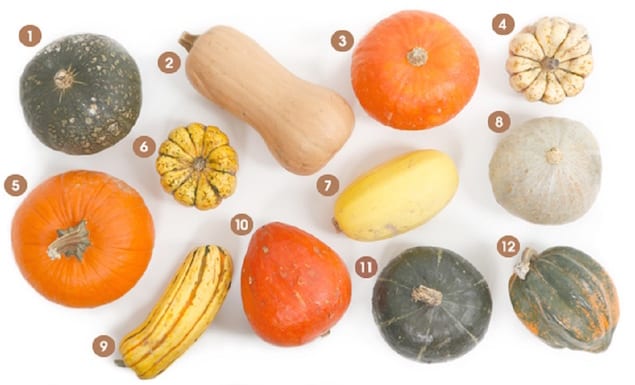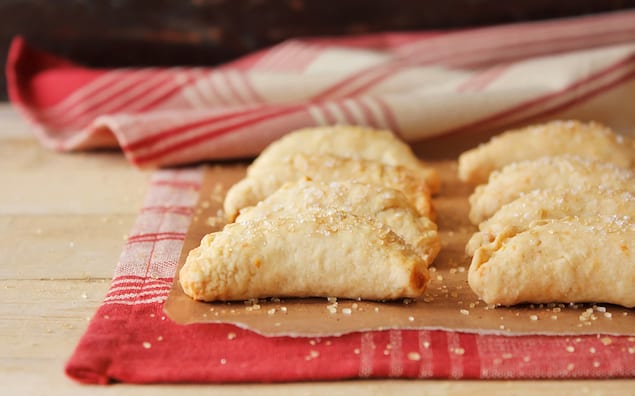Sweeter, heartier squash is one of the perks of cooler weather. Learn about a few of the delicious varieties and how best to prepare them.
By Jovina Coughlin

These cooler days are a great time to cook with winter squash. Sweeter, denser and more firm in texture than summer squash or zucchini, winter squashes take well to a wide variety of recipes and can be delicious in soups, casseroles, risotto, lasagna and even desserts.
Winter squash are harvested in the fall and these hardy vegetables will keep well through the cold winter months for which they’re named. Sugar pumpkins, acorn squash, spaghetti and butternut squash are probably the most common types to find at your local supermarket. The other varieties are worth seeking out at farmers’ markets and specialty markets. Regardless of the type, select winter squash that are blemish and bruise free with an intact stem and a heavy feeling for their size.
Naturally low in fat and calories, winter squash provide significant nutritional benefits. For example, one cup of baked butternut squash contains vitamins A (from beta carotene), B6, C and E, as well as magnesium, potassium and manganese. Flavors are generally mild-to-sweet, so squash won’t overwhelm other ingredients and can easily be incorporated into seasonal recipes. The orange and yellow flesh helps brighten dishes, especially in the colder months, when variety and color can be hard to come by in seasonal produce. Don’t be discouraged by winter squash’s size and tough exterior and you can sometimes find popular varieties, like butternut, in stores already peeled and cubed. See my earlier post on tips for cutting up winter squash.

1. Kabocha Squash
Characteristics: The squat, green kabocha—the Japanese word for squash—has a nutty, earthy flavor with just a touch of sweetness. It’s similar in shape and size to a buttercup squash, but the base points out and not in.
2. Butternut Squash
Characteristics: A slim neck and bulbous bottom give the butternut squash its distinctive bell shape. The muted yellow-tan rind hides bright orange-yellow flesh with a slightly sweet taste. To make butternut squash easier to handle, cut the neck from the body and work with each section separately.
3. Red Kabocha Squash
Characteristics: The red kabocha is squat, like its green counterpart, and has faint white stripes running from top to bottom. While the green kabocha is savory, the red kabocha is sweeter.
4. Carnival Squash
Characteristics: Combine an acorn squash with a sweet dumpling squash and you get a carnival squash. While the carnival squash’s exterior resembles both of its relatives, its yellow flesh is mellow and sweet. Use it wherever acorn squash or butternut squash is called for in a recipe.
5. Sugar Pumpkin
Characteristics: Sugar pumpkins are prized for their classic pumpkin flavor, as well as for their thick and fleshy walls. If you’d like to opt out of canned pumpkin for your baking and make your own purée instead, use a sugar pumpkin.
6. Sweet Dumpling Squash
Characteristics: This whitish-yellow and green squash is small and compact, making the whole squash the perfect-size for an individual serving. The flesh tastes very much like a sweet potato and the skin is edible is as well. Use sweet dumpling squash in recipes calling for sweet potato or pumpkin.
7. Spaghetti Squash
Characteristics: Take a fork to the inside of a cooked spaghetti squash and you’ll understand how this squash got its name. If you’re in search of a healthy pasta alternative, try this very mild-tasting squash.
8. Blue Hubbard Squash
Characteristics: Most blue Hubbard squash are huge and bumpy and are often sold as pre-cut wedges. Some varieties, like the Blue Ballet, are smaller, making it easier to store and prepare at home. Underneath the gray-blue skin is sweet-tasting orange flesh.
9. Delicata Squash
Characteristics: This particular winter squash, with its pale yellow shading, most closely resembles its summer squash relatives. The thin skin is edible, but also more susceptible to bruises and rot. When cooked, the delicata has a consistency similar to that of a sweet potato—creamy and soft—although the flavoring is more earthy.
10. Red Kuri Squash
Characteristics: Like all Hubbards, the red kuri has an asymmetrical, lopsided look to it. However, the red kuri is smaller and easier to handle. Its yellow flesh is smooth and has a chestnut like flavor.
11. Buttercup Squash
Characteristics: Compact and green with paler green stripes, the buttercup can closely resemble a kabocha squash but it has a distinctive circular ridge on the bottom. On some, the ridge may surround a more pronounced bump, or “turban.” A freshly cut buttercup may smell like a cucumber, but once cooked, its orange flesh becomes dense.
12. Acorn Squash
Characteristics: This mild flavored squash is named for its acorn like shape. Choose one with a dull green rind; an acorn squash that’s turned orange will have tough and fibrous flesh.
Mediterranean Squash with Lemon Sauce
This is a vibrant side dish that loves to be served beside chicken of similar spices. Get the recipe here.

Sweet Squash Turnovers
It’s not all about pumpkin at the dessert table. These turnovers can be filled with any winter squash you like. Get the recipe here.














